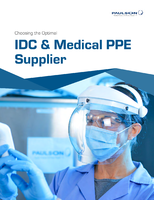Hs-Druck on Growth Curve with Ten-Colour KBA Rapida 106
Share:
Founded just seventeen years ago, hs-Druck has evolved from a four-man enterprise into a 60-employee business with 3,000m² (around 31,000ft²) of production space. At the end of January joint managing directors Helmut Hörmanseder and Herbert Seidl fired up their first KBA Rapida 106. The ten-colour perfector press for five-backing-five boasts a high level of automation that includes flying job changes, inline quality monitoring and all the other features that define a world makeready champion.
Hs-Druck looks back on a turbulent past. After setting up the business, gaining a foothold in the fiercely competitive commercial market proved a Herculean task. Right from the start the two founders and managing directors saw themselves as service providers. Timely delivery, quality and a fast turnaround were their top priorities. It is this outlook that has fuelled growth. Hs-Druck prints a raft of products ranging from business cards to bulky catalogues. Its main line of business is literature for the tourist trade. A fulfilment spin-off offers customised distribution services for hoteliers and tourist associations, and mails 20,000 to 30,000 items per day. Hs-Druck can also handle logistics: its finished-goods store alone has 350 pallet slots.
Speed is key
The Rapida 106's hour came when Helmut Hörmanseder and Herbert Seidl started searching for a cost-effective new press capable of handling both short-run work and longer runs of 500 to 50,000 sheets. It had to be a ten-colour version to allow the fifth units to be used for coating, perforating or special colours for catalogues. Otherwise anything that cut changeover times was a must - for example DriveTronic SPC for simultaneous plate changing and blanket washing. "Dedicated plate cylinder drives revolutionised sheetfed offset," says a delighted Helmut Hörmanseder. "The ten plates on the Rapida 106 can be changed faster than the five plates on our other medium-format press." A flying job change capability will streamline the production of instruction manuals, which have around 160 pages and print runs of 3,000 copies.
The printers from Ried were also interested in the sidelay-free infeed: "We had often had trouble identifying the pull lay during the second pass and where ink densities were higher," explains Herbert Seidl. "With no-sidelay infeed this is no longer an issue, not least because the ten-colour press prints everything in one pass."
Rapida 106 creates reserve shift
Previously the company operated two B1 presses in three shifts, but now most of the work is done on the Rapida 106. As a result weekend production, which was more or less a permanent necessity, has been dropped and this has reduced labour costs substantially, which in turn has cut printing costs. Productivity has also soared with the new Rapida, freeing up shift time that can be used to handle the seasonal fluctuations in business that are typical of the tourist trade.
When the Rapida 106 was installed the company had long reached the limits of its capacity, and was even having to turn down work or outsource it to other printers. That is no longer the case. Between 31 January and mid-June the Rapida 106 printed over ten million sheets or almost 400 jobs using 550 formes. QualiTronic Professional inline quality control has slashed overcounts. For repeat jobs just 200 sheets are calculated, compared with 600 previously. On top of this, makeready for a perfecting job takes no longer than for a standard job. It is here that modern high-tech presses like the Rapida 106 demonstrate their enormous output.
At present the Rapida operates with reduced levels of alcohol in the fount solution (3.5% instead of 8%), but can also run alcohol-free. Eliminating alcohol emissions from the press room will be yet another point in its favour among production staff, who were closely involved in the choice of press. Ease of operation, practical automation features and the reduction in workload associated with integrated quality monitoring have all contributed to employees' willingness to work with the new press. And thanks to ink pumping from central tanks there is virtually no need for them to get their hands dirty.
All-in service for high-growth tourist industry
Helmut Hörmanseder and Herbert Seidl differ from many other commercial printers in offering customers an all-in service. This extends from the initial concept, photography, design and marketing to mailing at cheaper, high-volume rates and personalisation via digital print. In addition to its fulfilment spin-off hs-Druck works with allied companies in Salzburg. This enables it to sustain an image as a universal provider, offer customers more favourable all-in prices and achieve better margins than it could purely as a printer. Tourist literature is still a growth market, and in 2010 experienced a double-digit increase in sales from which hs-Druck also benefited.
Website: www.hs-druck.at




